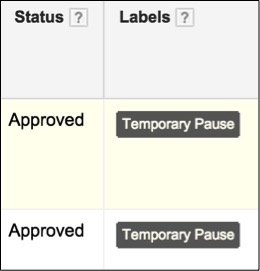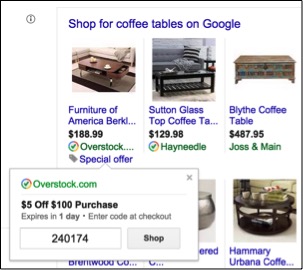Ad copy should generally be refreshed every 4 – 6 weeks, however, some clients run promotions on a regular basis. In order to improve click-thru-rate (CTR) and conversions, we naturally want to emphasize these promotions in our ads. The challenge is that creating these ads can be time consuming, especially if promotions are updated weekly. Once the promotion is complete, these ads need to be paused and non-sale ads need to be resumed.
In order to streamline the ad copy process, there are tasks that can be completed. These tasks will help to make the process more efficient and automate some of the repetitive work.
Utilize A “Temporary Pause” Label
Often times when running promotional copy you’ll want to pause existing ads. Your intent is to resume these ads once the promotion is over, but with the rest of your everyday tasks it can be forgotten. Thus, it makes sense to automate the process and take one less task off your plate.
Within the “Labels” section of AdWords you can create a label called “Temporary Pause.”

The next step is to apply this label to the ads you will pause during the promotion period. After applying the label, create a rule to resume the ads when the promotion ends.

If you know that these ads will be re-enabled at the same time every week, set the rule to run every week at the same time. Conversely, you can set a rule to pause the temp ads at the same time every week, which leads into the next task.
Label All Promotional Ads
Everything discussed in the previous section applies to promotional ads as well. By labeling these ads you can easily setup rules to enable and pause at the right times. In conjunction with the previous rule, your promotional ads should pause at the same time your temp ads go live and vice versa. There is more work up front, but the ad scheduling is automated.
The other benefit of labeling your promotional ads (and all ads for that matter) is it makes for easy reporting. If a client asks how the promotion during the week of 3/2 performed against that of 3/9, you can easily segment the data by label.
Keep In Mind The 80-20 Rule
The 80-20 rule states that in anything, 80% of the outcome is attributed to 20% of the entity. In PPC, it may mean that 80% of your account conversions come from 20% of the ad groups. Or 80% of PPC traffic comes from 20% of the overall keywords.
This concept is important to consider when writing promotional ads. You should be writing copy in the ad groups that are going to have the greatest impact. For example, you may decide to only write ads in ad groups that have seen at least 5,000 impressions over the last 30 days. In an ideal world you would write promotional copy for all ad groups in the account, but that can be too time consuming and the effort may not be worth the reward. The four hours spent writing promotional copy for all ad groups that will only net a handful more conversions could have been spent building new campaigns, expanding into other channels, and more.
Keep in mind this rule as you go through your other account optimizations. It’s not about creating more busy work for yourself, but rather spending your valuable time in areas that will net meaningful results.
Create Uniform Copy
For site wide promotions (ie: 20% off or free shipping), generally one of the description lines can be the same for all ads. Let’s say that we have two ad groups around “oval coffee tables” and “square coffee tables.” Normally, both description lines would speak to the specific coffee table theme. If we’re running a 20% off sale we can utilize the same text for description line one.


By using the same description line we can do more cutting and pasting both in the interface and Editor tool instead of manually writing text. Though only a small adjustment, this step can shave significant time off of ad copy creation.
Bonus Tip – Merchant Promotions
For those running Google Shopping ads, you are able to schedule your promotions in the Merchant Center interface. Promotions are seen when searchers click on the “Special offer” link.

In order to run Shopping promotions you’ll need to enter this information:
- Promo ID
- Target country and location
- Title
- Redemption code
- Product applicability
- Effective date range
Final Thoughts
Though promotional ad copy can pay big dividends, the process of writing these ads can be time consuming and tedious. There will always be a certain amount of manual labor needing to be done, but the process can be streamlined. Focus on where these ads will make the biggest impact and make use of Google’s tools. Writing uniform copy, creating labels, and scheduling ads will make the process smoother and easier to handle as new promotions are constantly rolled out.



